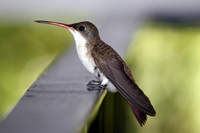Spring is an exciting time, especially with three little ones. It marks the chance to finally get outside after a long winter. Unfortunately, in spring there is often too much mud to be outside as often as we would like.
Something I have found to combat the mud blues and get ready for spring is to make a big deal about putting out hummingbird feeders. Hummingbirds are one of the most exciting birds to watch, especially for kids. They are fast, they are loud, and are easy to find and watch since they are not easily scared off by people.
It is fun to keep an eye on the hummingbird’s migration at www.hummingbirds.net/map. This promotes a whole host of smarty-pants learning opportunities. Map skills, computer skills, estimation skills, and is just plain exciting!
Our family prefers to set up a humming bird feeder to view from our living room window. Our family just puts out one feeder, and we usually get 3 or 4 regulars. Hummingbirds are kind of like goldfish – the bigger the tank, the bigger the fish, only the more feeders, the more birds!
Keeping a hummingbird feeder in working order is a great introduction to chores for even the littlest child. Kids can see direct results from their chores, and experience direct consequences. Nothing makes you feel worse about shirking your duties than when a hungry little bird flies up to an empty feeder, and then looks in the window at you wondering where their food is!
Here are a few tips to get you started:
- Position your feeder carefully. Keep in mind neighborhood cats as you try to put the feeder out of leaping distance.
- It is easier and cheaper to make your own nectar: Bring a 4:1 water: sugar mixture to an extremely slight boil. Let cool. Fill your feeder. Really, that’s it. (you can keep extra in the fridge, and do not use food coloring)
- When picking out a feeder consider:
- Ease of cleaning. I have found that some very attractive feeders are impossible to clean.

- Ease of filling. When pouring in the nectar mix, be sure you can set the feeder on the counter without it falling over. A funnel may be necessary for some feeders.
Bees, ants and butterflies may take advantage of the feeder too. That is okay! Just be sure to clean the feeder regularly and keep children away (this avoids bee stings and sticky messes).
If your little ones get into this project, there is no end to how far you can take it. Research into a bird/butterfly garden or just an idea of a new porch plant may inspire your family to enjoy nature with a new interest.
Contributed by Kathleen Clark of Palmyra, mother of three. She is a lover of anything that takes place outdoors.











